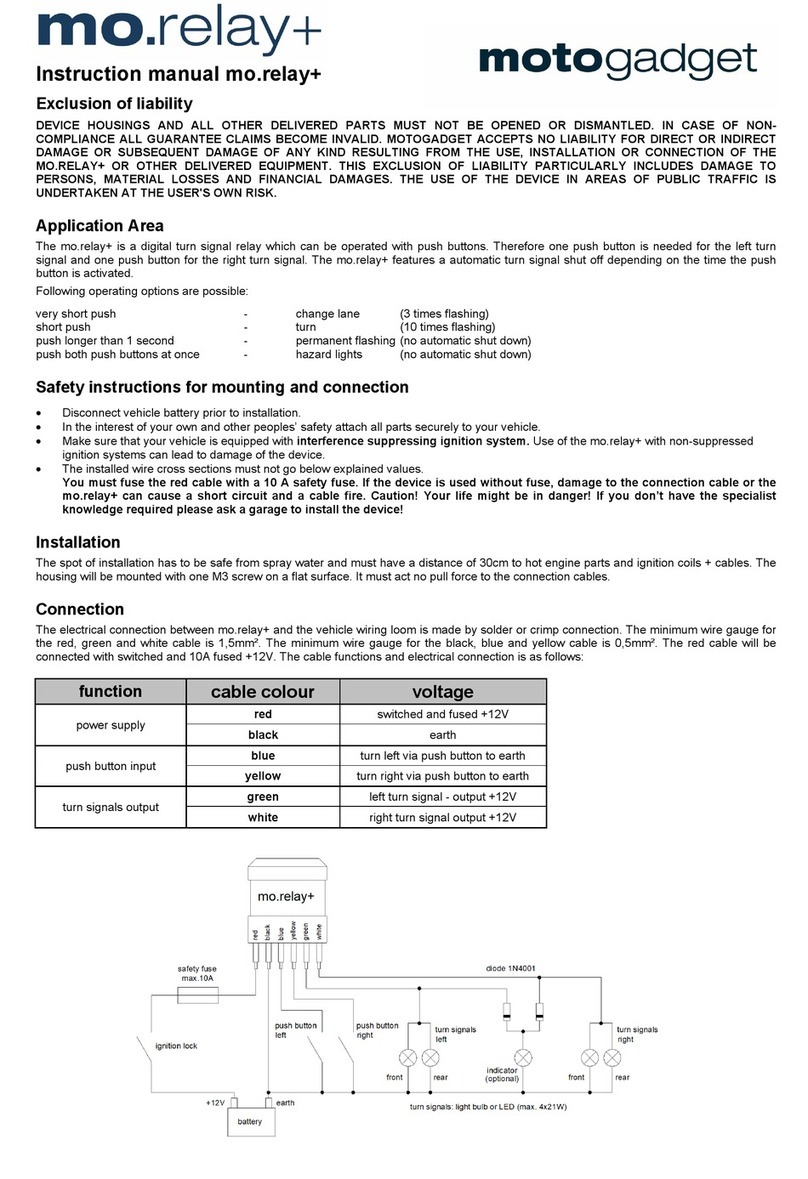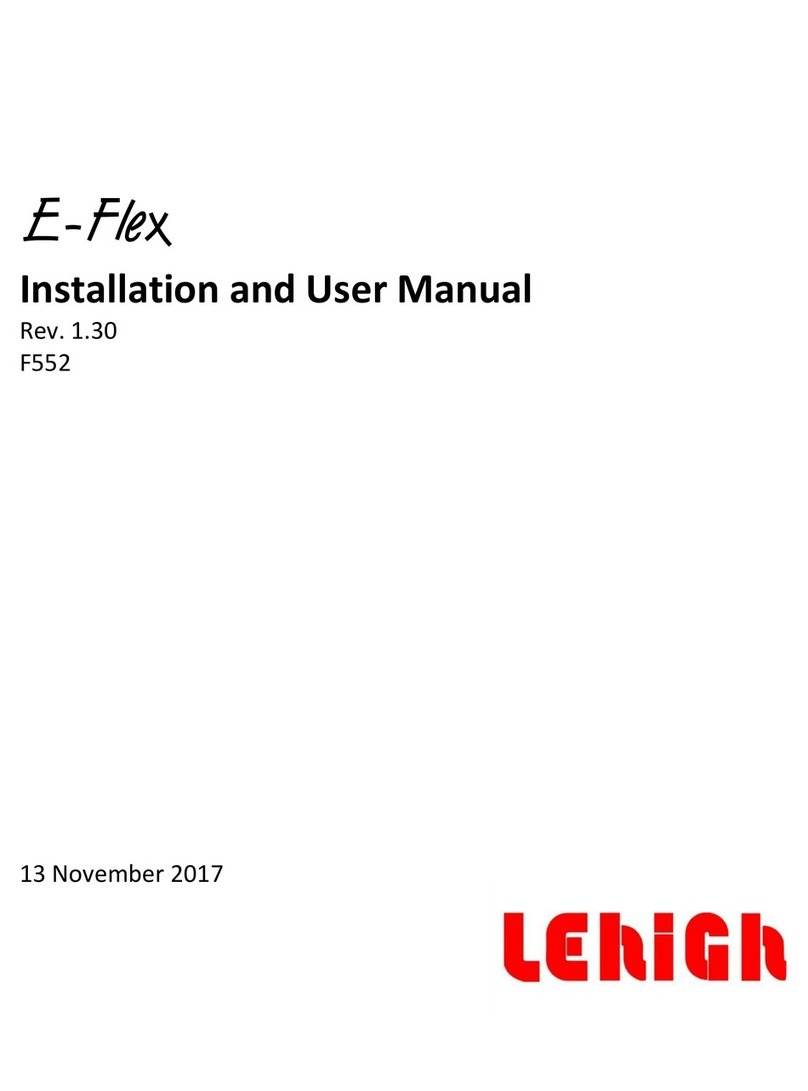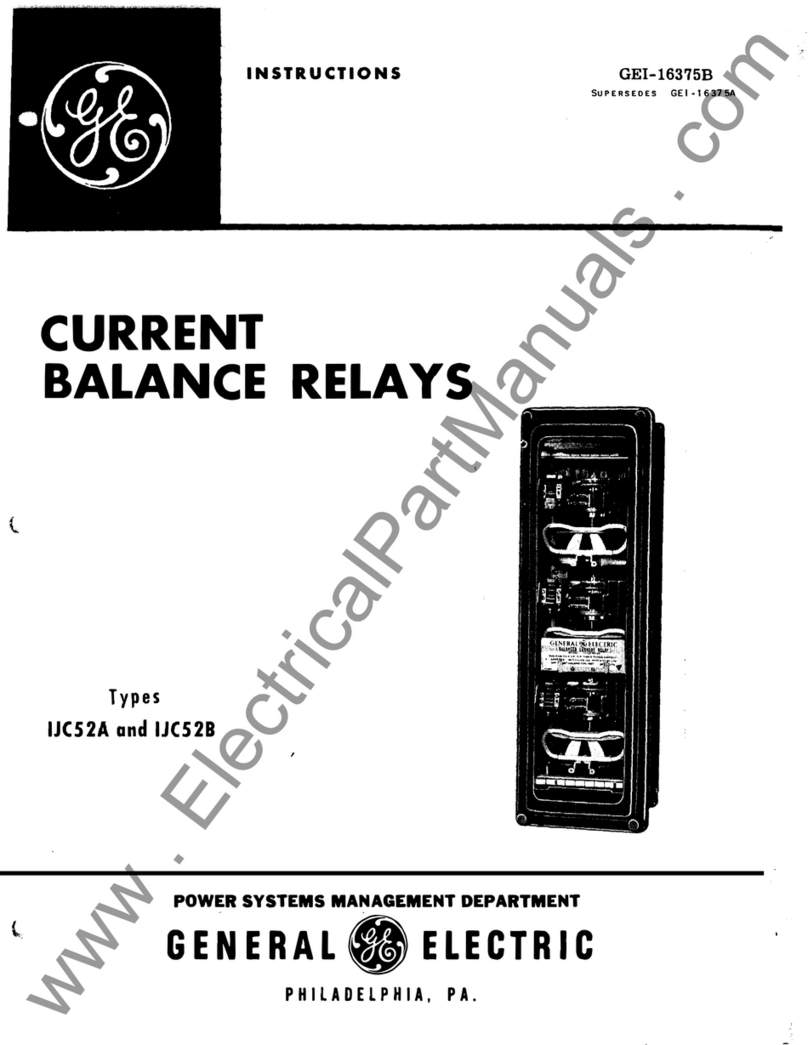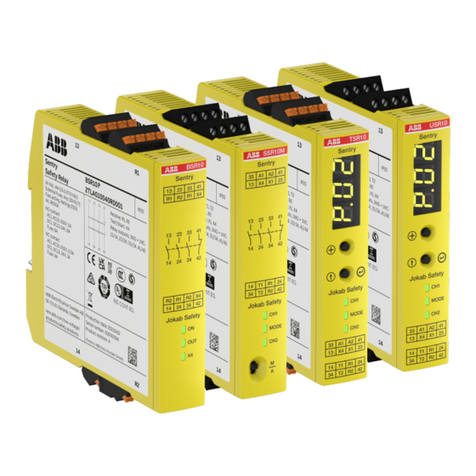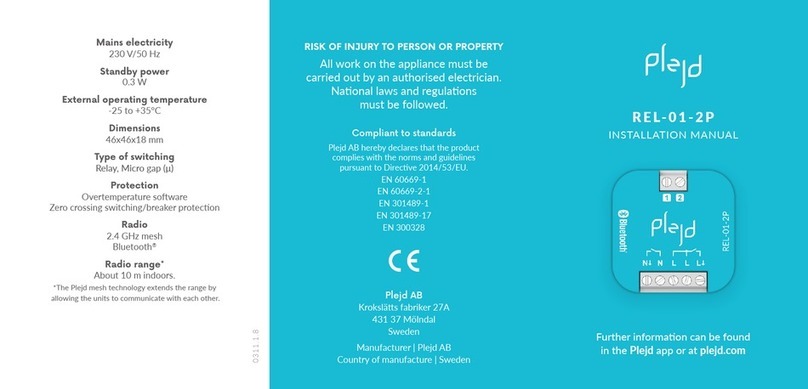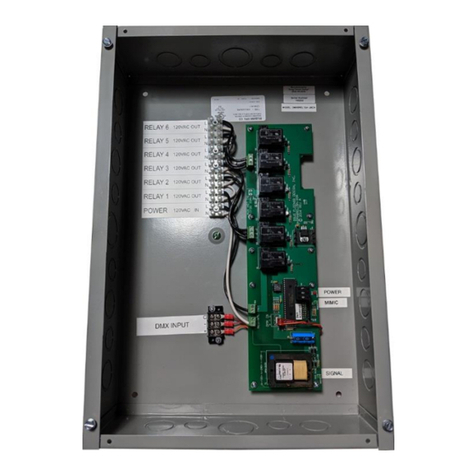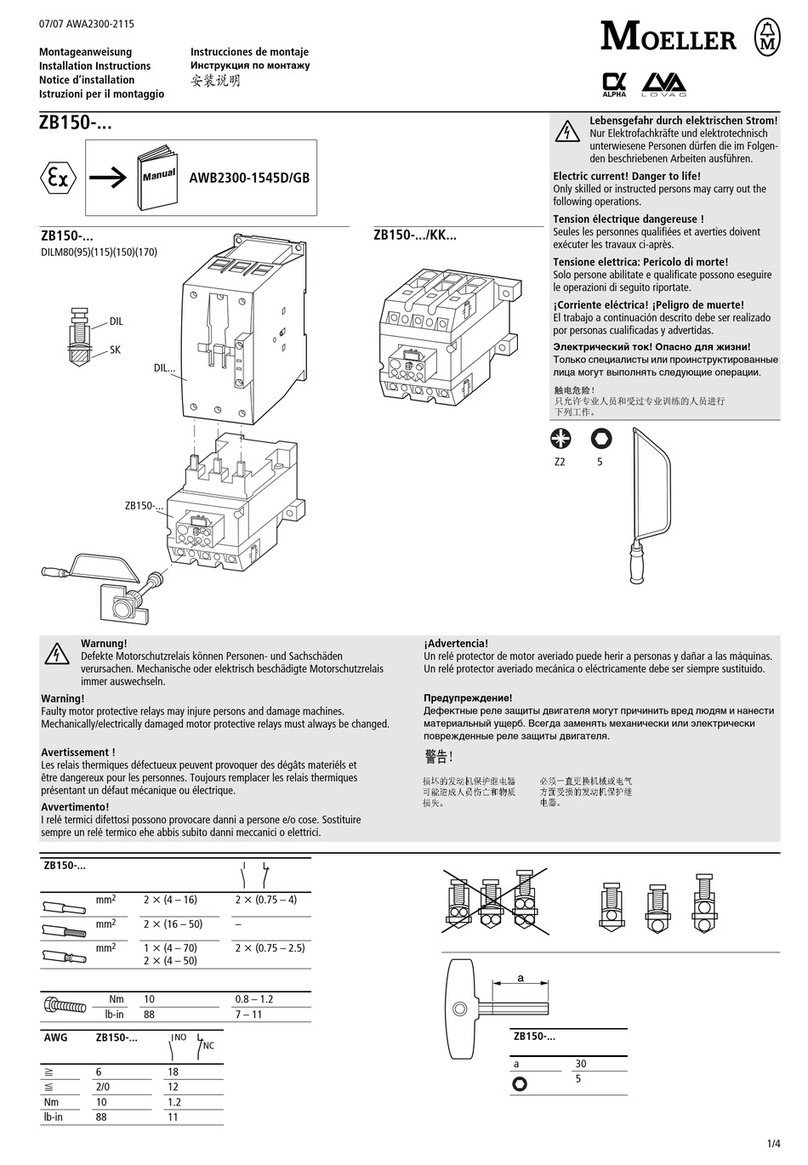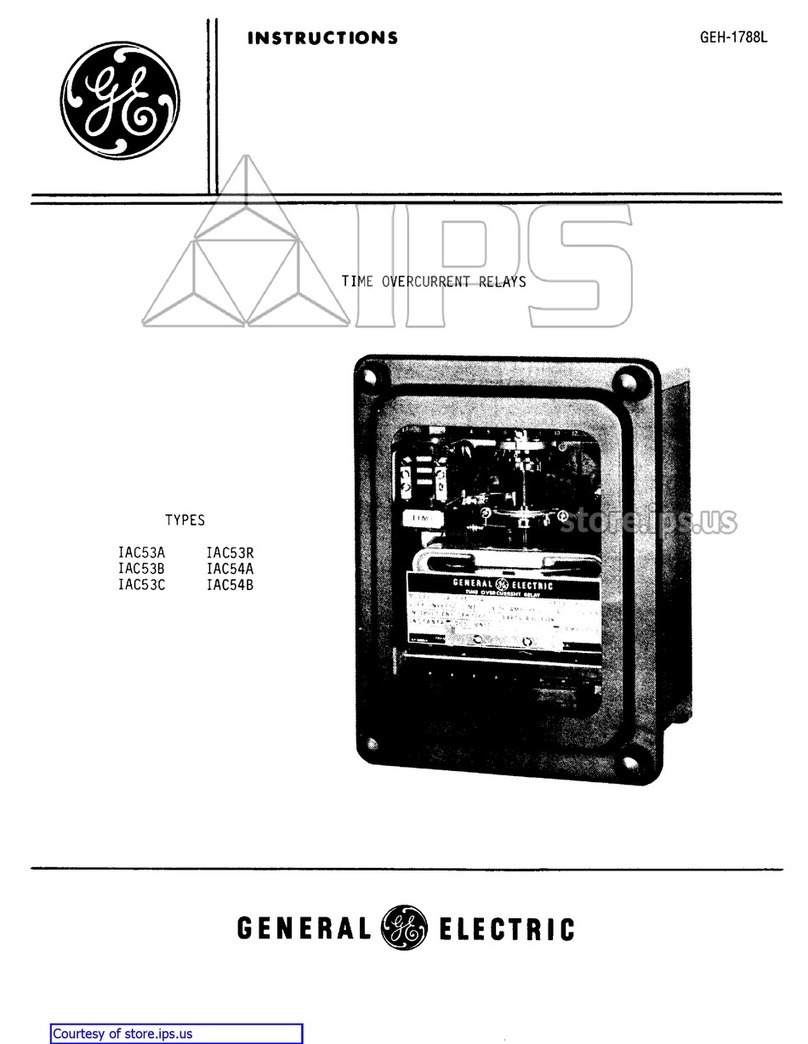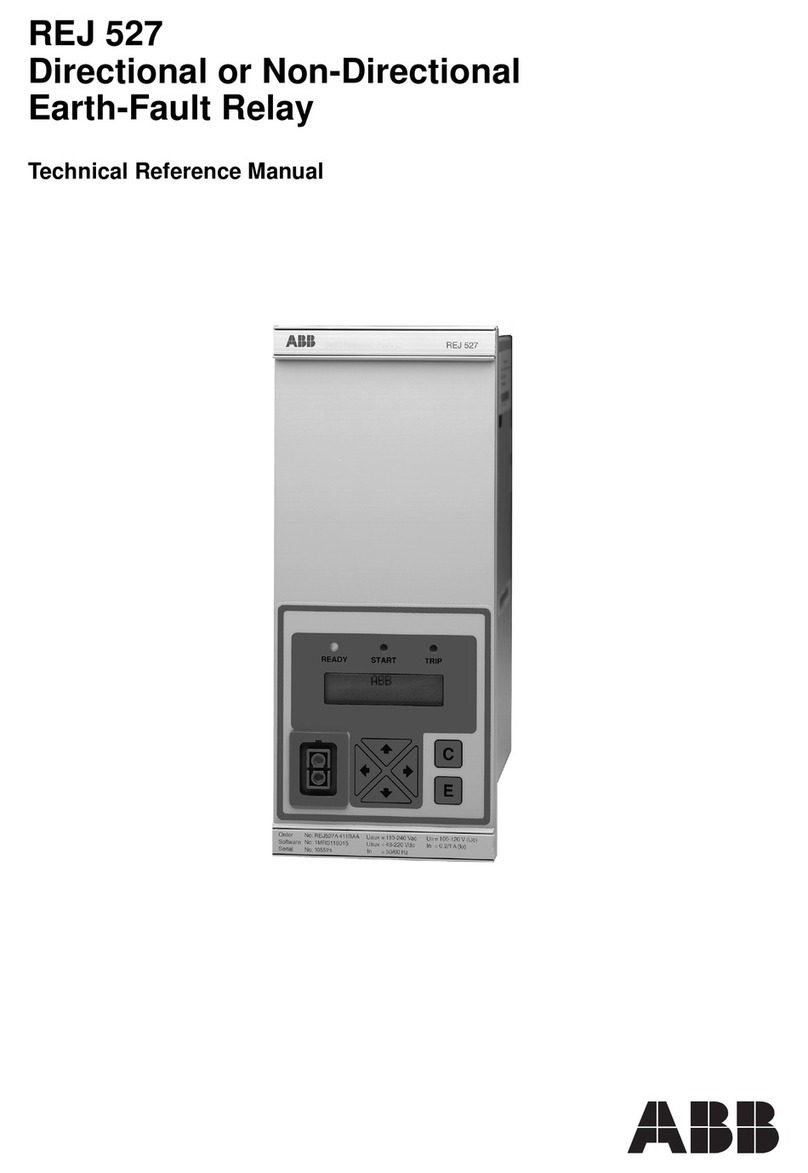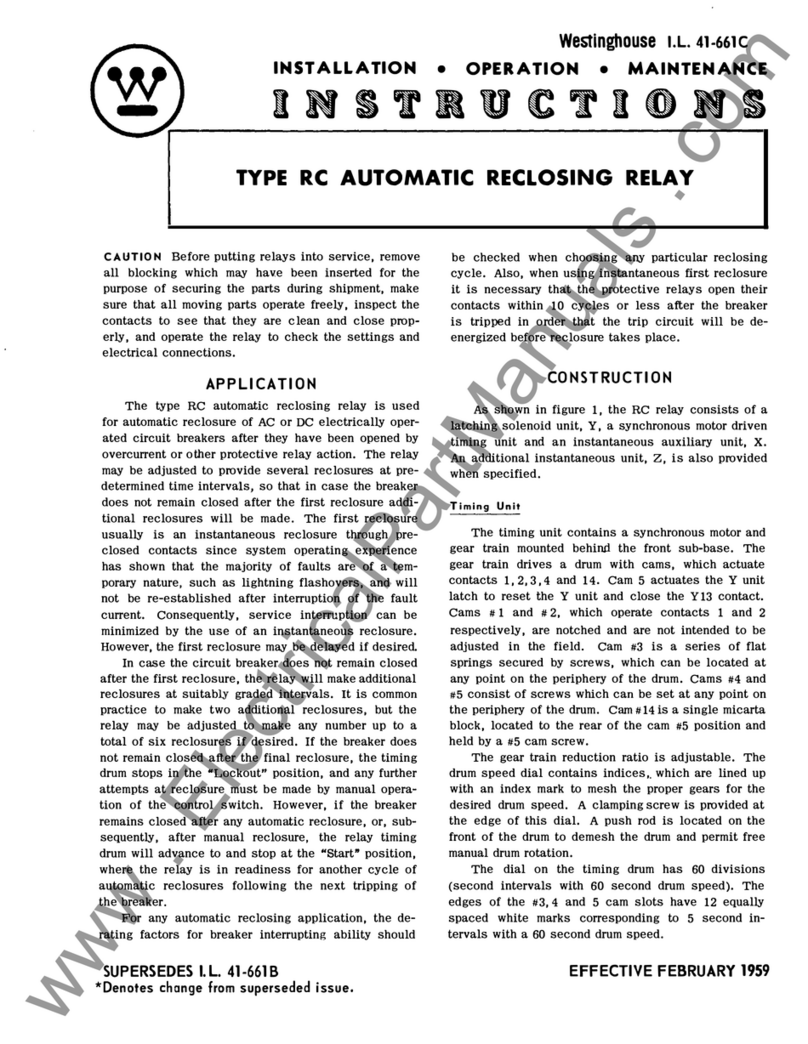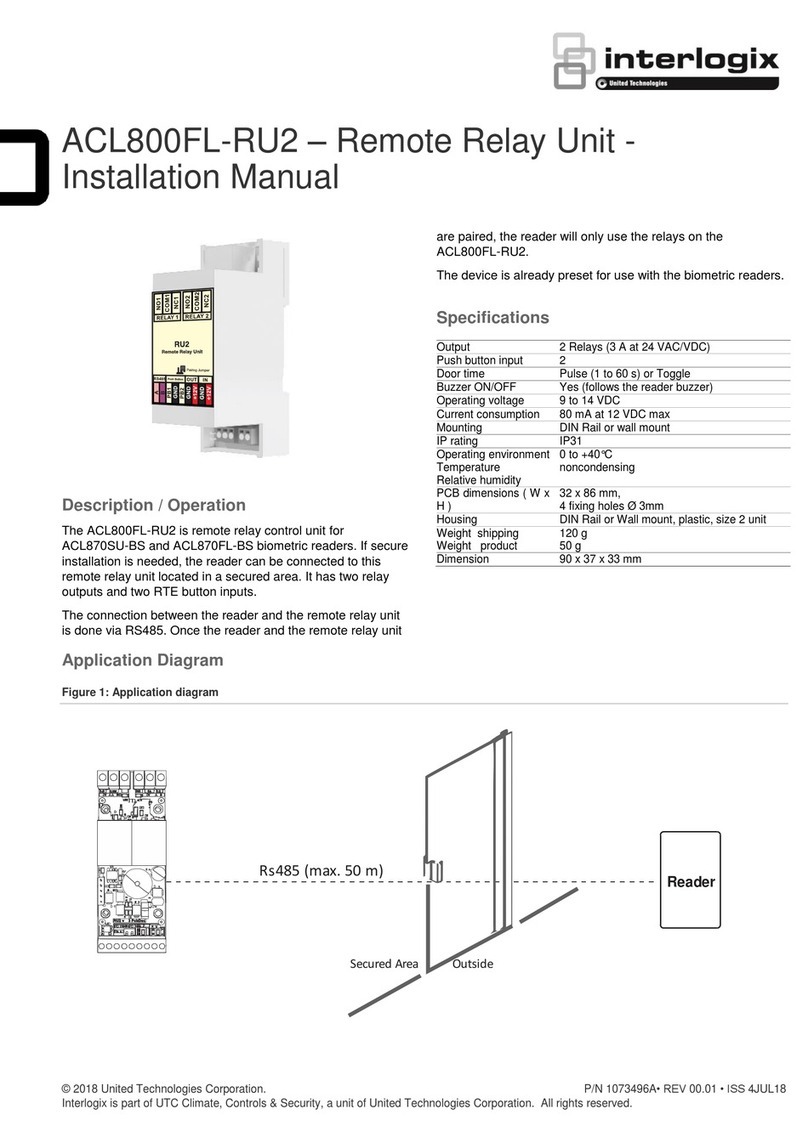BECKWITH ELECTRIC M-0420 User manual

i
TABLE OF CONTENTS
TABLE OF CONTENTS
M-0420 Multifunction Relay
Instruction Book
Chapter 1 Introduction
1.1 Foreword ................................................................................................ 1–1
1.2 Before You Begin ................................................................................... 1–2
1.3 Configuration As Shipped ...................................................................... 1–2
1.4 Description ............................................................................................. 1–3
1.5 Design Considerations........................................................................... 1–5
1.6 User Considerations .............................................................................. 1–7
1.7 Options ................................................................................................... 1–8
1.8 Accessories ............................................................................................ 1–9
1.9 References ............................................................................................. 1–9
Chapter 2 Application
2.1 Protective Applications .......................................................................... 2–1
Islanding Protection (81U, 81O, 27, 59) ............................................... 2–1
Ferroresonance Protection (59I) ........................................................... 2–1
Utility-Side Ground Fault Protection and Phase Voltage
Unbalance Protection (27N, 59N) ......................................................... 2–2
Phase Fault Protection (51V, 67) .......................................................... 2–2
Directional Power (32F, 32R) ................................................................ 2–2
Anti-Motoring Protection (32R) .............................................................. 2–2
Ground Fault Protection (59N, 51N, 50N) ............................................ 2–2
Negative Sequence Overcurrent Protection (46) ................................. 2–3
Backup Phase Fault Protection (51VC/VR) .......................................... 2–3
VT Fuse-Loss Protection (60FL) ........................................................... 2–3
Power OK Status ................................................................................... 2–3
2.2 Trip Configuration vs. Applications ....................................................... 2–3
2.3 Intertie Protection ................................................................................... 2–4
2.4 Generator Protection.............................................................................. 2–7
2.5 Setpoints............................................................................................... 2–11
2.6 Functions .............................................................................................. 2–12
81O/81U Over Frequency/Under Frequency ................................... 2–12
59/27 Overvoltage/Undervoltage ...................................................... 2–13
59I Peak Overvoltage........................................................................ 2–14

ii
M-0420 Instruction Book
59N/27N Overvoltage/Undervoltage,
Neutral Circuit or Zero Sequence ....................................................... 2–15
Ground Fault Detection Using 59N and Broken-Delta VTs ............... 2–16
Ground Fault Detection Using 27N and 59N with One VT ................ 2–17
51V Inverse Time Overcurrent, Three-Phase
with Voltage Control or Voltage Restraint........................................... 2–18
51N Inverse Time Overcurrent, Neutral Circuit................................ 2–24
50/50N Instantaneous Overcurrent,
Three-Phase and Neutral Circuits ....................................................... 2–25
46 Negative Sequence Overcurrent ................................................. 2–26
32 Directional Power, Three-Phase.................................................. 2–28
67 Phase Directional Overcurrent Option ........................................ 2–30
79 Reconnect Time Delay................................................................. 2–32
60FL VT Fuse-Loss Detection .......................................................... 2–33
2.7 Fault Recorder ..................................................................................... 2–33
Chapter 3 Front Panel Controls
3.1 Introduction............................................................................................. 3–1
3.2 Target/Status Indicators and Controls .................................................. 3–3
3.3 Serial Interfaces (COM1 and COM2).................................................... 3–3
Chapter 4 Operation
4.1 Introduction............................................................................................. 4–1
4.2 Software Flow ........................................................................................ 4–1
Power-On Self-Test and Status Screens .............................................. 4–1
Default Message Screens ..................................................................... 4–1
Access Screens ..................................................................................... 4–5
Menu Flow .............................................................................................. 4–5
4.3 Moving Between Menus ........................................................................ 4–5
4.4 Entering Values ...................................................................................... 4–5
4.5 Access Codes ........................................................................................ 4–8
4.6 Enabling and Disabling Relay Functions .............................................. 4–8
Chapter 5 Menu Reference
5.1 Introduction............................................................................................. 5–1
5.2 Relay Functions ..................................................................................... 5–1
5.3 Review Setpoints ................................................................................... 5–2
5.4 Monitor Status ........................................................................................ 5–2
5.5 Configure Relays.................................................................................... 5–3
5.6 View Target History ............................................................................... 5–4
5.7 Fault Recorder ....................................................................................... 5–4
5.8 Read Counter ......................................................................................... 5–5

iii
TABLE OF CONTENTS
5.9 Communication ...................................................................................... 5–5
5.10 Setup Unit............................................................................................... 5–6
5.11 Exit Local Mode ..................................................................................... 5–7
5.12 Menus ..................................................................................................... 5–8
Chapter 6 Installation
6.1 Initial Setup Procedure .......................................................................... 6–1
6.2 Commissioning Checkout ...................................................................... 6–2
6.3 DIP Switches .......................................................................................... 6–4
6.4 Mechanical/Physical Dimensions .......................................................... 6–6
6.5 Suggested VT Connections ................................................................. 6–10
6.6 UL-Listed Terminal Block Connections ............................................... 6–10
Chapter 7 Test Procedures
7.1 Introduction............................................................................................. 7–1
7.2 Unit Setup............................................................................................... 7–1
7.3 Equipment Required .............................................................................. 7–2
7.4 Test and Equipment Setup .................................................................... 7–2
7.5 Diagnostic Test Procedures .................................................................. 7–5
Output Test ............................................................................................ 7–5
Input Test ............................................................................................... 7–6
LED Test ................................................................................................ 7–7
Button Test ............................................................................................. 7–7
Display Test ........................................................................................... 7–8
Backlight Test......................................................................................... 7–8
COM1 Test ............................................................................................. 7–9
COM2 Test ............................................................................................. 7–9
Other Diagnostic Mode Commands .................................................... 7–10
Power-On Self-Test ............................................................................. 7–11
59 RMS Overvoltage, 3-Phase ......................................................... 7–12
59N RMS Overvoltage, Neutral Circuit or Zero Sequence.............. 7–14
59I Peak Overvoltage........................................................................ 7–16
27 RMS Undervoltage, 3-Phase ....................................................... 7–18
27N RMS Undervoltage, Neutral Circuit or Zero Sequence............ 7–20
60 FL V.T. Fuse Loss Detection ....................................................... 7–22
81O Over Frequency ......................................................................... 7–23
81U Under Frequency ....................................................................... 7–24
50 Instantaneous Overcurrent, 3-Phase .......................................... 7–25
50N Instantaneous Overcurrent, Neutral ........................................ 7–26
51 Inverse Time Overcurrent, 3-Phase ............................................ 7–28
51VC Inverse Time Overcurrent with Voltage Control, 3-Phase ... 7–30
51VR Inverse Time Overcurrent with Voltage Restraint, 3-Phase 7–32
51N Inverse Time Overcurrent, Neutral ........................................... 7–34
46 Negative Sequence Overcurrent ................................................. 7–35
67 Phase Directional Overcurrent .................................................... 7–36
32F Directional Power, Forward Power, 3-Phase............................ 7–38

iv
M-0420 Instruction Book
32R Directional Power, Reverse Power, 3-Phase ........................... 7–40
79 Reconnect Time Delay................................................................. 7–42
7.6 Self-Calibration Procedure................................................................... 7–43
Test Equipment .................................................................................... 7–43
Test Setup ............................................................................................ 7–43
Calibration Procedure .......................................................................... 7–44
Chapter 8 Design Changes
8.1 Introduction............................................................................................. 8–1
8.2 Host Processor Software Versions ....................................................... 8–1
Appendix A Theory of Operation
A.1 Introduction............................................................................................. A–1
A.2 System Block Diagram .......................................................................... A–2
A.3 Discrete Fourier Transform ................................................................... A–3
Estimation of RMS Value of the Signal................................................. A–4
Instantaneous Peak Voltage.................................................................. A–5
Estimation of the Fundamental Frequency ........................................... A–5
Calculation of Sequence Components .................................................. A–6
Calculation of Power/Power Factor ....................................................... A–6
Implementation of Inverse Time Overcurrent Relay Curves................ A–7
A.4 Acknowledgments .................................................................................. A–7
A.5 References ............................................................................................. A–7
Appendix B Self-Test Error Codes
Appendix C Communications
C.1 Introduction............................................................................................. C–1
C.2 The BECOCOM®Protocol..................................................................... C–1
C.3 Communication Ports............................................................................. C–1
C.4 Direct Terminal Communications via COM1......................................... C–2
Procedure for Terminal Communications via COM1............................ C–2
Appendix D Printed Circuit Board Interconnections
Appendix E Configuration Record Forms

v
TABLE OF CONTENTS
Figures Page
Chapter 1 Introduction
1-1 Traditional Relaying vs the M-0420 Multifunction Relay ...................... 1–4
1-2 M-0420 Block Diagram .......................................................................... 1–6
1-3 M-0420 Functional Diagram .................................................................. 1–6
1-4 M-0428A BECOPLOT™ Fault Data Analysis Software Output ........... 1–8
Chapter 2 Application
2-1 Intertie Protection – Typical One-Line Diagram ................................... 2–4
2-2 Intertie Protection – Typical Three-Line Diagram................................. 2–5
2-3 Intertie Protection – Trip Logic .............................................................. 2–6
2-4 Generator Protection – Typical One-Line Diagram .............................. 2–7
2-5 Generator Protection – Typical Three-Line Diagram ........................... 2–8
2-6 Generator Protection – Trip Logic ......................................................... 2–9
2-7 Example of Trip Characteristics: Over and Under Frequency ........... 2–11
2-8 Ground Fault Detection Using 59N and Broken-Delta VTs ............... 2–16
2-9 Ground Fault Detection Using 27N and 59N with One VT ................ 2–17
2-10 Voltage Restraint (51VR) Characteristic ............................................. 2–18
2-11 Definite Time Overcurrent Curve ........................................................ 2–20
2-12 Inverse Time Overcurrent Curve......................................................... 2–21
2-13 Very Inverse Time Overcurrent Curve ................................................ 2–22
2-14 Extremely Inverse Time Overcurrent Curve ....................................... 2–23
2-15 Negative Sequence Overcurrent Inverse Time Characteristic .......... 2–27
2-16 Phase Directional Overcurrent (67) Trip Characteristics ................... 2–31
Chapter 3 Front Panel Controls
3-1 M-0420 Front Panel ............................................................................... 3–2
Chapter 4 Operation
4-1 Software Flow ........................................................................................ 4–2
4-2 Power-on Self-Test and Status Screens............................................... 4–3
4-3 Default Message Screens ..................................................................... 4–4
4-4 Access Screens ..................................................................................... 4–6
4-5 Front Panel Operation ........................................................................... 4–7

vi
M-0420 Instruction Book
Chapter 5 Menu Reference
5-1 M-0420 Menu Flow, Version 4.01 Software ......................................... 5–8
5-2 Voltage Relay: RMS Overvoltage, 3-Phase (59) .................................. 5–9
5-3 Voltage Relay: Peak Overvoltage, 3-Phase (59I) .............................. 5–10
5-4 Voltage Relay: RMS Undervoltage, 3-Phase (27) .............................. 5–11
5-5 Voltage Relay: RMS Overvoltage Neutral Circuit or
Zero Sequence..................................................................................... 5–12
5-6 Voltage Relay: RMS Undervoltage, Neutral Circuit or
Zero Sequence (27N) .......................................................................... 5–13
5-7 Frequency Relay: Overfrequency (81O) ............................................. 5–14
5-8 Frequency Relay: Underfrequency (81U) ........................................... 5–15
5-9 Current Relay: Inverse Time Overcurrent, 3-Phase (51V) ................ 5–16
5-10 Current Relay: Phase Directional Overcurrent, 3-Phase (67) ........... 5–17
5-11 Current Relay: Inverse Time Overcurrent, Neutral (51N),
Instantaneous Overcurrent, Neutral (50N) ......................................... 5–18
5-12 Current Relay: Negative Sequence Overcurrent (46) ........................ 5–19
5-13 Power Relay: Forward Overpower (32F) ............................................ 5–20
5-14 Power Relay: Reverse Overpower (32R) ........................................... 5–21
5-15 Reonnect Relay (79) ............................................................................ 5–22
5-16 Review Setpoints ................................................................................. 5–23
5-17 Configuration of Phase Overcurrent Relay-67 Enabled ..................... 5–24
5-18 Example of Target History Screens .................................................... 5–27
Chapter 6 Installation
6-1 Internal Configuration DIP Switch–60 Hz ............................................. 6–5
6-2 Mounting Dimensions for GE L-2 Cabinet ............................................ 6–6
6-3 Mounting Dimensions for Westinghouse FT-41 Cabinet...................... 6–7
6-4 M-0420 Side View .................................................................................. 6–8
6-5 External Connections ............................................................................. 6–9
6-6 Connections for Wye-Wye Connected VTs ........................................ 6–10
6-7 Connections for Open-Delta Connected VTs ..................................... 6–10
6-8 Connections for Delta-Wye Connected VTs ....................................... 6–10
6-9 Wire Terminations for External Connection as Required
for UL Listing ........................................................................................ 6–10

vii
TABLE OF CONTENTS
Chapter 7 Test Procedures
7-1 Voltage Input Configuration ................................................................... 7–4
7-2 Current Input Configuration ................................................................... 7–4
7-3 Single-Phase Voltage Input Configuration for Calibration.................. 7–43
7-4 Single-Phase Current Input Configuration for Calibration .................. 7–43
Appendix A
A-1 System Block Diagram .......................................................................... A–2
A-2 Frequency Response of the DFT Algorithm ......................................... A–4
A-3 Phasor Diagram ..................................................................................... A–6
Appendix C
C-1 Null Modem Cable: M-0420 COM1 to PC (9-pin)................................. C–3
C-2 Null Modem Cable: M-0420 COM2 to PC (25-pin)............................... C–3
Appendix D
D-1 M-0420 Board Interconnections ............................................................ D–1
Appendix E Configuration Record Forms
E-1 Functional Configuration Record ........................................................... E–2
E-2 Voltage Relay Setpoint Configuration Record ...................................... E–3
E-3 Frequency Relay Setpoint Configuration Record ................................. E–4
E-4 Current Relay Setpoint Configuration Record ...................................... E–5
E-5 Power and Reconnect Relay Setpoint Configuration Record .............. E–6
E-6 Internal DIP Switch Configuration Record ............................................ E–7

viii
M-0420 Instruction Book
Tables Page
Chapter 1 Introduction
1-1 M-0420 Device Functions ...................................................................... 1–3
Chapter 2 Application
2-1 Current Transformer Placement Considerations for
Generator Phase-to-Phase Fault Protection....................................... 2–10
2-2 Over (81O) and Under (81U) Frequency Setpoint Ranges ............... 2–12
2-3 Overvoltage (59) and Undervoltage (27) Setpoint Ranges................ 2–13
2-4 Peak Overvoltage (59I) Setpoint Ranges ........................................... 2–14
2-5 Overvoltage (59N) and Undervoltage (27N) Setpoint Ranges .......... 2–15
2-6 Delta/Wye Transformer Voltage-Current Pairs ................................... 2–19
2-7 Inverse Time Overcurrent with Voltage Control/
Voltage Restraint (51VC/VR) Setpoint Ranges .................................. 2–19
2-8 Inverse Time Overcurrent Neutral (51N) Setpoint Ranges................ 2–24
2-9 Instantaneous Overcurrent (50) and Instantaneous Overcurrent
(50N) Neutral Setpoint Ranges ........................................................... 2–25
2-10 Negative Sequence Overcurrent (46) Setpoint Range....................... 2–26
2-11 Directional Power (32) Setpoint Ranges............................................. 2–29
2-12 Phase Directional Overcurrent (67) Setpoint Ranges ........................ 2–30
2-13 Reconnect Time Delay (79) Setpoint Ranges .................................... 2–32
Chapter 6 Installation
6-1 Internal Configuration DIP Switch ......................................................... 6–4
Chapter 7 Test Procedures
7-1 Initial Settings ......................................................................................... 7–3
7-2 Output Test Terminal Contacts ............................................................. 7–5
7-3 Input Test Terminal Contacts ................................................................ 7–6
7-4 LED Designations .................................................................................. 7–7
Appendix B Error Codes
B-1 Self-Test Error Codes ............................................................................ B–1
Appendix C Communications
C-1 Communication Port Signals ................................................................. C–2
C-2 Terminal Commands .............................................................................. C–2
800-0420-IB-05 04/01

1–1
Introduction – 1
1Introduction
1.1 Foreword ....................................................................................1–1
1.2 Before You Begin .......................................................................1–2
1.3 Configuration As Shipped ..........................................................1–2
1.4 Description .................................................................................1–3
1.5 Design Considerations...............................................................1–5
1.6 User Considerations ..................................................................1–7
1.7 Options .......................................................................................1–8
1.8 Accessories ................................................................................1–9
1.9 References .................................................................................1–9
1.1 Foreword
Beckwith Electric's multifunction protective relays
such as the M-0420 and M-0430 offer a number
of advantages to electric utilities seeking to opti-
mize their protective systems:
Self-Diagnostics –The relay is constantly
checking its own operation. If not functioning
correctly, it alerts the operator through an output
contact. In contrast, single-function electro-
mechanical relays must be tested periodically by
station maintenance personnel.
Fault Recording –The digital electronics in the
relay continuously record the waveform of the
voltage and current inputs, along with the status
contact inputs. When the breaker opens, as
indicated by the 52b contact, the waveform data
is stored in memory for later review when
investigating the cause of the trip.
Compact Size –The relay occupies a panel
space less than 8 inches wide and 21 inches high,
yet can operate fourteen protective functions.
Operation –All settings can be established or
changed using the front panel controls and
alphanumeric display.
Communication –Through a computer connec-
tion, all functions can be monitored and setpoints
changed by a PC-compatible computer, or by a
laptop PC plugged into the front panel.
Functions –The functions respond in the same
manner as do electromechanical relays, includ-
ing time delays, and the nomenclature is the same.
This Instruction Book provides details of the
installation and operation of the relay. Our team
of applications engineers stands ready to assist
you in applying this equipment to your electric
system. Please don't hesitate to call us at (727)
544-2326.

1–2
M-0420 Instruction Book
1.2 Before You Begin
The Beckwith Electric M-0420 Multifunction Re-
lay is a sophisticated relay applicable to a wide
variety of applications. While it has been careful-
ly designed to be easy to install and configure, if
you're a first-time user, we suggest that you ac-
quaint yourself with its operation in the following
manner:
•Read this Introduction for a general over-
view of the relay.
•Read Chapter 2, Application, for informa-
tion on using the relay to protect genera-
tors and to initiate appropriate breaker
commands in response to faults and abnor-
mal conditions.
•Refer to Chapters 3, Front Panel Controls
and 4, Operation, to familiarize yourself with
the layout and operation of the front-panel
controls.
•Refer to Chapter 5, Menu Reference, for
detailed information on the functions you will
be using in your application.
•Read Chapter 6, Installation, for mounting
dimensions, external connections, initial set-
up, and verification routines.
•Refer to Appendix E, Configuration Record
Forms for forms on which to record your
relay configuration and DIP switch settings.
•Refer to publication M-0429A BECOCOM®/
M-0428A BECOPLOT®User’s Guide for
information on configuring and interrogating
the relay via a personal computer running
the optional BECOCOM communications
software package, and for information on
plotting downloaded fault data via the optional
BECOPLOT software package.
The M-0420 Multifunction Relay Instruction Book
has been organized to address the needs of dif-
ferent parts of your organization. If you are re-
sponsible for verifying that the relay conforms to
specifications as received, please turn to Chap-
ter 6, Installation for initial setup, and to Chap-
ter 7, Test Procedures.
If you are responsible for the operation of the
relay in a specific application, please turn to Chap-
ter 2, Application, for information on enabling
specific functions and entering setpoints. If you
are responsible for the mechanical and electrical
installation of the relay, please refer to Chapter
6, Installation.
If you are interested in a description of the re-
lay's capabilities, please read this Introduction
thoroughly, and refer to Appendix A, Theory of
Operation, for more detailed information.
Please don't hesitate to call your local sales
representative or Beckwith's application engineers
(727-544-2326) for assistance in resolving any
problems.
1.3 Configuration As Shipped
You can become familiar with the basic opera-
tion of the relay before it is installed by connect-
ing it to the appropriate power input and setting
it up on a bench or desktop. Even without any
test voltages connected, you will be able to step
through the various menus and note the indica-
tions on the liquid crystal display (LCD) and the
various light-emitting diodes (LEDs). The formal
initial setup information is presented in Chapter
6, Installation, which includes Figure 6-5 show-
ing the external connections.
As shipped, the relay is in the following configu-
ration:
•the clock has been disabled
•the second setpoints on various functions
have been disabled, and do not appear on
the display
•the DIP switch (at bottom of inside case)
has been set as below; setting is also de-
tailed on the yellow or pink tag attached to
the equipment. (The yellow tag is for 60 Hz;
the pink tag is for 50 Hz.)
1)noitcelesresurofton(FFO
2)noitarbilacnahtrehtar,noitarepolamron(NO
3)edomcitsongaidnahtrehtar,noitarepolamron(NO
4)esahpynanodesnestnerruc/rewopesrever(NO
5)enil-ot-enilroftesstupniTV(NO
6)caV021siegatlovyradnocesTV(FFO
7)gatwolley-zH06siycneuqerfmetsys(FFO
)gatknip-ZH05siycneuqerfmetsys(NO
8)ylnotnenopmoclatnemadnufyb,SMR(FFO

1–3
Introduction – 1
•the 51 voltage control and voltage restraint
functions are disabled
•the access code feature is disabled
•options supplied with the equipment are noted
on the yellow or pink (50 Hz) tag. These
are:
phase directional overcurrent function
(device 67)
input voltage (120 V ac, 125 V dc,
48 V dc, 24 V dc)
neutral current input (nominal 5 A or
1 A)
•a set of replacement fuses is attached to
one of the handles. These fuses are mounted
on the internal PC board.
1.4 Description
The M-0420 Multifunction Relay is a
microprocessor-based unit that uses digital signal
processing technology to provide 14 different
protective relaying functions (see Table 1-1) in
one compact unit. The M-0420 is designed to
provide these functions in two basic applications:
generation, and generator/system interties. Within
these basic applications, the various devices in
the M-0420 can provide protection in cases of
islanding, ferroresonance, ground or phase faults,
generator motoring, and other abnormal operating
conditions. Internal relay functions are listed in
Table 1-1. The nomenclature follows the standards
of ANSI/IEEE Std. C37.2-1979, Standard Electric
Power Systems Device Function Numbers.
noitcnuF noitpircseD
72 esahp-3,egatlovrednUSMR
N72ecneuqeSoreZrotiucriClartueN,egatlovrednUSMR
23 dna)F23(drawroF,esahp-3,yaleRrewoPlanoitceriD
)R23(esreveR
64esahp-3,yaleRtnerrucrevOecneuqeSevitageN
05 esahp-3,yaleRtnerrucrevOsuoenatnatsnI
N05lartueN,yaleRtnerrucrevOsuoenatnatsnI
N15 lartueN,yaleRtnerrucrevOemiTesrevnI
V15 htiw,esahp-3,yaleRtnerrucrevOemiTesrevnI
tniartseRegatloVrolortnoCegatloV
95 esahp-3,yaleRegatlovrevOSMR
N95 oreZrotiucriClartueN,yaleRegatlovrevOSMR
ecneuqeS
I95 esahp-3,yaleRegatlovrevOkaeP
*76esahp-3,yaleRtnerrucrevOlanoitceriDesahP
97 yaleDemiTtcennoceR
O18ycneuqerfrevO
U18 ycneuqerfrednU
LF06noitceteDssoLesuF.T.V
lanoitpO*
Table 1-1 M-0420 Device Functions

1–4
M-0420 Instruction Book
Since all functions are incorporated into one pack-
age, much less panel space and panel wiring is
required than for individual relays, as illustrated
in Figure 1-1. You can set and examine all func-
tions via a menu-driven, 2-line by 24-character
LCD display or via remote communication access.
Once you reprogram a value, the new value is
placed in nonvolatile memory where it is unaf-
fected by a loss of power or other system distur-
bance.
The M-0420 Multifunction Relay includes multi-
ple output and status input contacts. It can be
powered by 24, 48, or 125 V dc, or by 120 V ac,
50/60 Hz power, and is rated according to ANSI/
IEEE C37.90 and C37.90.1. The relay includes
self-test diagnostics, internal calibration correc-
tion, communication capability via two RS-232C
ports, real-time display of system parameters, trip
targets, and capture of fault data that occur dur-
ing a system disturbance.
Figure 1-1 Traditional Relaying vs the M-0420 Multifunction Relay
AF
50/
51V
BF
BFCF
CF
Phase Voltage
Relay Functions
Phase Current
Relay Functions
81
O/U
32
3F
46
Directional Power
Relay Function
Reconnect Time
Delay
Relay Function
79
59I
50/51
N27/59
NPeak
Overvoltage
Relay Function
Negative Sequence
Current Unbalance
Relay Function
59I
Neutral
Voltage Current Relay
Functions
Over/Under
Frequency
Relay Function
AF
67
BF
67
CF
67
27/
59
AF
A B C
F
50/
51V 50/
51V
27/
59 27/
59
PRIDE
M0420
MULTIFUNCTIO
N
TARGETS
POWER
59
OVERVOLTAGE
27N
UNDERVOLTAGE
59N
OVERVOLTAGE
27
UNDERVOLTAGE
81O
OVERFREQUENCY
81U
UNDERFREQUENCY
Made in U.S.A.
50
INSTANTANEOUS
OVERCURRENT
51/67
OVERCURRENT
51N
OVERCURRENT
50N
INSTANTANEOUS
OVERCURRENT
32
DIRECTIONAL
OVERPOWER
46
NEGATIVESEQUENCE
OVERCURRENT
TARGETRESET/
LAMPTEST
SERIALINTERFACE
COM1
ENTER
SETPOINT
SELECT
FUNCTION
RELAYOK
ENTER
EXIT
PHASE ELEMENTS
NEUTRALELEMENTS
®
VOLTAGE RELAY
VOLT freq curr
FAULT
RECORDED BREAKER
CLOSED
CO.INC.
BECKWITH
ELECTRIC
➞

1–5
Introduction –1
1.5 Design Considerations
There are basically two approaches in the de-
sign of digital relays. In the first approach, the
microprocessor simply replaces the relay logic
and does not process the voltage and current
signals. The performance of these relays depends
on the accuracy of the analog components used,
and is subject to dc offsets and gain drift with
temperature, supply voltage changes, or aging.
In the second approach, the microprocessor both
processes the signals and performs the logic,
providing a simpler design and offering perfor-
mance advantages. The advent of low-cost digi-
tal signal processors (DSPs), microprocessors
designed especially for the efficient numerical
procedures required, paved the way for the de-
sign of a digital relay using state-of-the-art digital
signal processing techniques, thereby eliminat-
ing the problems inherent with analog hardware.
The Beckwith Electric M-0420 Multifunction Relay
follows this second approach: analog signal-
processing hardware is replaced with a DSP.
Various parameters of the input signals are
estimated using digital signal-processing
algorithms. The voltage and current input signals
of the relay are modeled as sinusoidal signals
corrupted by dc offset and harmonic components.
These signals can be characterized by various
parameters such as rms value, peak value, rms
value/phase angle, and frequency of the
fundamental component.
However, while DSPs are highly effective for signal-
processing applications, they are not very effi-
cient for general purpose applications and have
limited memory space. Therefore, the relay uses
a dual-processor architecture. The DSP executes
all the signal-processing algorithms, while a gen-
eral-purpose (host) processor manages input/
output and other overhead functions, monitors the
keyboard for operator requests, updates memo-
ries for setpoint values, facilitates operator inter-
action via the alphanumeric display, establishes
two-way communication using the RS-232C se-
rial ports, analyzes the data from the DSP, and
issues the trip commands.
Figures 1-2 and 1-3 present a general overview
of the hardware design and functional operation
of the relay. As shown in these diagrams, the
inputs to the relay, filtered to remove higher or-
der harmonics, are multiplexed and then passed
through an Analog-to-Digital Converter (ADC) to
the DSP, which performs a discrete Fourier trans-
form (DFT) 16 times per cycle for each of the
inputs. The host processor performs all input/output
and overhead functions, including monitoring of
the status inputs, and ultimately analyzes the data
from the DSP to determine the need for a trip
command.
One significant design feature of the relay is
automatic correction of the sensing transformer
error caused by ambient temperature excursions.
Voltage transformers exhibit enough internal
resistance so that the internal regulation of the
transformer results in a significant error due to
changes in temperature. The relay includes a
temperature sensor mounted in the enclosure to
measure directly and accurately the internal
temperature of the relay. This temperature signal
is coupled through the ADC to the DSP, which
processes the information to determine the
appropriate factor required to correct the sensing
transformer error.
The relay uses an algorithm based on the DFT
to compute the frequency and to determine the
phase angle for real/reactive power measurements.
The algorithm uses voltage phasor estimates ob-
tained from the DFT to compute reliable estimates
of frequency unaffected by dc and harmonic com-
ponents in the signal. Additionally, deriving the
positive sequence voltage phasor from the DFT
means that the frequency function will continue
to operate should any single- or two-phase fault
occur.

1–6
M-0420 Instruction Book
Figure 1-2 M-0420 Block Diagram
VTs & CTs
2K byte
Dual-Ported
RAM
Digital Signal
Processor
(DSP)
TMS 32015
8K byte
ROM
12-bit
Analog-to-Digital
Converter
(ADC)
i
va
b
c
n
a
b
c
n
Programmable
Gain Amplifier
DSP Processor Board
Input Board
Host Processor Board
MUX
Address/Data Bus
128K byte Flash-
Programmable
ROM
Host Processor
10 MHz 64180
Front Panel Board
LED
Targets
Front-Panel
Controls RS 232
Serial I/O
Analog Multiplexer
Anti-Aliasing Low-Pass Filters (LPF)
Output Board
Relay
Outputs Contact
Inputs
2-Line by 24-Character
Liquid Crystal Display
32K byte RAM
EEPROM
RAM, Clock
10 Year
Lithium Battery
Power Supply Board
Power Supply
i
i
i
v
v
v
i'
a
b
c
i'
i'
Opto-Isolation Opto-Isolation
Temperature
Sensor
COM1 COM2
Figure 1-3 M-0420 Functional Diagram
ANALOG
INPUTS M–0420 MULTIFUNCTION RELAY
1. FILTERS
2. MUX
3. PGA
4. ADC
DIGITAL
SIGNAL
PROCESSOR
SERIAL
INTERFACE TARGETS USER
INTERFACE
HOST
PROCESSOR
RELAY
SETTINGS
IN
NON-
VOLATILE
MEMORY
OUTPUT
RELAYS
1.TRIP
2. RECON ENABLE
3. SELF TEST
ALARM
4.TRIP ANNUN
5. VT FUSE LOSS
POWER
SUPPLY
AC OR
DC
VO LTAGE
3-PHASES
1-NEUTRAL
CURRENT
3-PHASES
1-NEUTRAL
STATUS
INPUT
1. BREAKER
STATUS 52b
2. VT FUSE LOSS
6. PWR OK STAT

1–7
Introduction –1
1.6 User Considerations
In the design of the M-0420 Multifunction Relay,
careful consideration was given to making its use
as similar as possible to that of the traditional
protective relays that are still found throughout
typical power systems.
Ease of Use and Compatibility
In order to provide maximum compatibility with
existing equipment, care was taken that traditional
electromechanical nomenclature was used for
setpoint values and trip characteristics. For
example, the inverse time overcurrent functions
(devices 51 and 51N) use industry-accepted time-
curve families (Definite Time, Inverse, Very Inverse,
and Extremely Inverse) based on the ABB (formerly
Westinghouse) CO and COV curves. Within each
family, the operator selects the tap setting and
time dial setting just as though doing so on an
electromechanical relay.
The user-friendly controls and display provide easy
access to the various functions. The software is
completely menu driven through a liquid crystal
alphanumeric display (LCD). All functions and
values can easily be set using the front panel
buttons and the rotary knob.
Communication Capabilities
One of the important features of the relay is its
capability for remote communications. The relay
provides two RS-232C serial ports for communi-
cation via modem or direct serial connection. In
a typical communications application, the rear-
panel communication port is permanently con-
nected to a modem, while the front-panel port is
kept free for on-site programming via a laptop
computer.
Fault Recording and Analysis
The multifunction relay provides up to 96 cycles
of fault waveform data with selectable distribu-
tion of the time before and after the breaker trip.
This data can be downloaded via an MS-DOS
computer running the M-0429A BECOCOM®Com-
munications Software. Once downloaded, the data
can be analyzed using the associated M-0428A
BECOPLOT®Fault Data Analysis Software pack-
age.
The fault data analysis software runs on an
MS-DOS computer, enabling the user to plot fault
data, specifying which waveforms and inputs are
displayed, and at what scale. (The sample plot
shown in Figure 1-4 displays all waveforms.) A
marking feature enables the user to mark any
time span and zoom instantly to display it at full
screen, and specific points on the waveform may
be tagged in order to read actual waveform values.
Displayed plots can be printed using the DOS
Print Screen command.
Self-Diagnostics
To ensure confidence in the relay’s operation,
the system software provides many hardware and
software diagnostic checks, some of which are
performed continuously, and others on processor
reset. Should a failure occur, an output relay is
activated, and processing stops in order to prevent
mis-operation. Likewise, if system power fails, an
output contact closes.
Internal Calibration Correction
One of the most important and novel advantages
of the relay is its capability for correcting its
calibration through internal software. Most existing
static and microprocessor relays are designed
with a number of trim pots to trim the signal offsets,
and gain and phase inaccuracies. This can be a
time-consuming process, during both factory
calibration and routine calibration by the customer.
The relay does away entirely with trim pots for
calibration. The gain and phase angle errors are
computed using calibration coefficients stored in
nonvolatile memory. When the calibration mode
is selected, the relay display prompts the operator
to connect the voltage inputs to 120 V and the
current inputs to 5 A with zero phase angle between
the signals. Then, the relay computes the gain
and phase angle errors and stores the appropriate
correction coefficients for use by the relay software.

1–8
M-0420 Instruction Book
1.7 Options
In addition to the selectable power inputs of 24,
48, or 125 V dc/120 V ac (50 or 60 Hz), the relay
can provide the following optional functions:
67 Phase Directional Overcurrent
The relay is available with the phase directional
overcurrent function (67). In addition to the definite
time delay provided on the 67 function, the
directional element of the 67 function can be used
to provide directional control of the 51V function,
thereby realizing a directional inverse time
overcurrent function.
Neutral Current Input
The relay is available with a nominal neutral current
input of 5 A (standard) or 1 A (optional). When
the 1 A input option is chosen, the relay internally
scales the current by a factor of 5 and the settings
and status display work as though the 5 A nominal
neutral current is selected. With the 1 A neutral
current input, the current-related settings and status
display values should be divided by 5 to obtain
the actual current values.
H:Help X:Zmin x:Zmout Y:Zmin y:Zmout ->:Next <-:Prev C:Cursor R:Read Q:Quit
File: F ULT.D T Time Tag: 11/15/91 10:13:32
52b
1.2 pu
0.6
Va
0.6
1.2 pu
0.6
Vb
0.6
0.1 pu
0.05
Vn
0.05
4 pu
2
Ia
2
4 pu
2
Ic
2
0.4 pu
0.2
In
0.2
60FL
t me
(ms)
1 pu
0.5
Vc
0.5
1004.2 1058 1111.9 1165.7 1219.6 1273.4 1327.3 1381.1 1435 1488.9
4 pu
2
Ib
2
52b Breaker
Input Status
Fuse Loss
Currents
Voltages
Figure 1-4 M-0428A BECOPLOT®Fault Data Analysis Software Output

1–9
Introduction –1
1.8 Accessories
M-0319 Dropping Regulator
The M-0319 Dropping Regulator is a resistor/zener-
diode regulating device used to produce 125 V
dc from a 250 V dc battery source. The regulator
can be used to allow an M-0420 Multifunction
Relay with the 120 V ac/125 V dc power supply
option to operate from a 250 V dc source.
M-0421 PRIDE®Test Adapter
The M-0421 Test Adapter makes bench testing
the relay an easy process. The adapter provides
a complete set of rear terminals for testing the
unit after it has been removed from its draw-out
case.
M-0429A BECOCOM®Communications
Software Package
The BECOCOM communications software runs
on an MS-DOS computer, providing remote ac-
cess to the relay via either direct serial connec-
tion or modem. BECOCOM provides the following
communication functions:
•Setpoint interrogation and modification
•Line status real-time monitoring
•Downloading recorded fault data
BECOCOM also provides remote access to the
Beckwith Electric M-0430 Multifunction Relay.
M-0428A BECOPLOT®Fault Data Analysis
Software Package
The M-0428A BECOPLOT Fault Data Analysis
Software runs on any MS-DOS computer, enabling
you to plot and print fault data downloaded (us-
ing the BECOCOM communications software
package) from the M-0420 and M-0430 relays.
Figure 1-4 illustrates typical data output.
M-0422/M-0423 Serial Communications
Cables
The M-0422 cable is a 10 foot straight-through
RS-232 cable for use between the relay's rear-
panel (COM2) port and a modem. This cable has
DB25 (25-pin) connectors at each end.
The M-0423 cable is a 10 foot null-modem RS-232
cable for direct connection between a PC and
the M-0420 front-panel (COM1) port. This cable
has DB9 (9-pin) connectors at each end.
1.9 References
The references that follow provide additional in-
formation about the use of digital technology in
protective relaying. References 12 and 13 present
more detailed information about the design and
relay applications, and are available upon request
from Beckwith Electric Co., Inc.
[1]
Grid Interconnection Performance Require-
ments and Current Practice
. Gas Research
Institute, Topical Report 87-0117, 1986.
[2]
IEEE Guide for Interfacing Dispersed Stor-
age and Generation Facilities with Electric
Utility Systems
. ANSI/IEEE Std. 1001-1988.
[3]
Intertie Protection of Consumer-Owned
Sources of Generation
, 3 MVA or Less. IEEE
Publication 88TH0224-6-PWR.
[4] ANSI/IEEE C37.102-1987 “
IEEE Guide for
AC Generator Protection
.”
[5] M.S. Sachdev (Coordinator),
Microproces-
sor Relays and Protection Systems
. IEEE
Tutorial Text, 88EH0269-1-PWR.
[6] W.E. Feero, W.B. Gish, and C.L. Wagner,
“
Overvoltages on Distribution System Gen-
eration Separated from the Power Systems
,”
Final Report ERM-8701-07, April 1987, Elec-
tric Research and Management, Inc., State
College, PA, 16804.
[7] A.G. Phadke, J.S. Thorp, and M.G. Adami-
ak, “
A New Measurement Technique for
Tracking Voltage Phasors, Local System
Frequency, and Rate-of-Change of Frequen-
cy
.”IEEE Transactions on PAS, vol. PAS-
102, No. 5, May 1983, pp. 1025-1038.
[8] David M. Denison, “
Application of Digital Fault
Recorders on the Tampa Electric Company
System
,”44th Annual Protective Relaying
Conference, Georgia Institute of Technolo-
gy, Atlanta, Georgia, May 2-4, 1990.
[9]
Electric Utility Systems and Practices
, 4th
Edition, Homer M. Rustebakke, John Wiley
& Sons, 1983.
[10]
Protective Relaying, Principles and
Applications
, J. Lewis Blackburn, Marcel
Dekker, Inc., 1987.

1–10
M-0420 Instruction Book
[11] C.F. Henville, “
Relay Replacement and Up-
grading Projects
,”Canadian Electrical As-
sociation 1991 Spring Meeting, Toronto,
Ontario, May, 1991.
[12] Murty V. V. S. Yalla, Donald L. Hornak, “
A
Digital Multifunction Relay for Intertie and
Generator Protection
,”Canadian Electrical
Association 1992 Spring Meeting, Vancou-
ver, B.C., March 1992.
[13] Murty V. V. S. Yalla, “
A Digital Multifunction
Protective Relay
,”IEEE Transactions on
Power Delivery, Vol. 7, No. 1, January 1992,
pp. 193-201.

2–1
Application –2
2Application
2.1 Protective Applications ..............................................................2–1
2.2 Trip Configuration vs Applications ............................................2–3
2.3 Intertie Protection .......................................................................2–4
2.4 Generator Protection..................................................................2–7
2.5 Setpoints...................................................................................2–11
2.6 Function ....................................................................................2–12
81O/81U Overfrequency/Underfrequency...............................2–12
59/27 Overvoltage/Undervoltage.............................................2–13
59I Peak Overvoltage ..............................................................2–14
59N/27N Overvoltage/Undervoltage, Neutral Circuit
or Zero Sequence ....................................................................2–15
Ground Fault Detection Using 59N and Broken-Delta VTs ...2–16
Ground Fault Detection Using 27N and 59N with One VT ....2–17
51V Inverse Time Overcurrent, 3-Phase, with
Voltage Control and Voltage Restraint....................................2–18
51N Inverse Time Overcurrent, Neutral Circuit ......................2–24
50/50N Instantaneous Overcurrent, 3-Phase
and Neutral Circuit ...................................................................2–25
46 Negative Sequence Overcurrent ........................................2–26
32 Directional Power, 3-Phase................................................2–28
67 Phase Directional Overcurrent Option ...............................2–30
79 Reconnect Time Delay .......................................................2–32
60FL VT Fuse Loss Detection.................................................2–33
2.7 Fault Recorder .........................................................................2–33
2.1 Protective Applications
The sections that follow discuss briefly the principal
applications of the M-0420 Multifunction Relay in
intertie or generator protection. Section 2.6,
Functions, discusses the individual functions in
detail, presenting setpoint ranges, increments, and
the initial default settings.
Islanding Protection (81U, 81O, 27, 59)
When a dispersed source of generation (DSG) is
suddenly islanded, the frequency will quickly shift
from 60.0 Hz (except for the improbable case of
an exact generation and load match), making the
measurement of frequency an excellent means
of detecting the island condition. The relay provides
both under frequency (81U) and over frequency
(81O) functions. The relay also provides both rms
undervoltage (27) and rms overvoltage (59)
functions that can be useful in detecting islanding.
Each has two setpoints with time delays from 1
to 8160 cycles, and magnitude range settings from
10 to 200 V.
Ferroresonance Protection (59I)
Lightly loaded islanded systems can experience
ferroresonance, where the system is in resonance
but the inductance is highly nonlinear as the
transformer core cycles in and out of magnetic
saturation. Under these conditions, the voltage
waveform will be distorted to the extent that the
peak voltage of the non-sinusoidal wave can be
dangerously high. Since the peak overvoltage (59I)

2–2
M-0420 Instruction Book
function of the relay detects the value of the
instantaneously sampled wave, it can act in
situations where a relay reacting to rms voltage
would not. The setpoint range is from 1.05 to 1.50
per unit, with a time delay variable from 1 to 8160
cycles.
Utility-Side Ground Fault Protection and
Phase Voltage Unbalance Protection (27N,
59N)
The relay provides both rms undervoltage and
rms overvoltage functions for the neutral circuit
(27N and 59N). Used together with one VT con-
nected from any one phase to ground, the 27N
and 59N devices are an effective means of de-
tecting the most common line-to-ground fault. A
fault on the phase that includes the VT will pull
that phase voltage low and initiate operation of
the 27N function. A fault on either phase without
the VT will result in S3 x normal voltage appear-
ing at the VT, initiating operation of the 59N.
The 59N may also be used to detect system phase
voltage unbalance conditions in conjunction with
three VTs. To do so, the VT secondaries are con-
nected in broken delta and the 59N device in-
serted. In this case, voltage at the 59N will be
zero so long as the three-phase voltages are
balanced, but will rise above zero with any un-
balanced condition, as will occur with a utility line
or ground fault.
Implementation of the 27N and 59N functions pro-
vides two setpoints each with a range setting of
10 to 200 V and a time delay of 1 to 8160 cycles.
Phase Fault Protection (51V, 67)
Time overcurrent relays (51), one per phase, are
basic to any protection scheme. This is the main
device used to trip circuits selectively and time-
coordinate them with other up- or downstream
devices. Four complete series of inverse time trip-
ping characteristics from Definite Time to Extremely
Inverse (based on the ABB CO and COV curves)
are included in the relay.
For intertie protection applications, the optional
phase directional overcurrent function (67) allows
greater selectivity for utility system faults, since
the directional element can be set to look toward
the utility system. As a generator protection re-
lay, the 67 function, looking into the generator,
can provide protection against accidental energi-
zation of the generator on turning gear. When
line-side CT inputs are used, this function can
also provide high-speed protection against gen-
erator winding faults. However, with line-side CTs,
the protection against winding faults during off-
line operation (when the breaker is open) is not
available from the 51V, 50, 46, or 67 functions.
Calculation of the current used for tripping is a
unique feature of this relay. The current is derived
from an RMS calculation, but (by user selection)
can also be computed based on either including
or not including the contribution of harmonics to
the value. Since it is not well established by the
industry whether the calculation should be based
simply upon the fundamental frequency component
or a broader frequency range, a simple switch
setting allows the operator to select either one.
Directional Power (32F, 32R)
Implementation of the directional power function
is straightforward, issuing a trip command when
the magnitude of the power flow (in either direc-
tion as selected) exceeds the setpoint for the pre-
scribed time. However, as opposed to reverse
power relays that rely on zero crossings for phase
angle information, the relay power calculation uses
the fundamental frequency phasor measurements
obtained from the DFT, and thus is immune to
harmonics in voltage and current signals. The
setpoints for either direction range from 0.02 to
3.0 pu, with time delays from 1 to 8160 cycles.
Anti-Motoring Protection (32R)
When the energy supply to the prime mover is
cut off while the generator is still on line, the gen-
erator will act as a synchronous motor driving
the prime mover. A reverse power relay is used
to detect this motoring. Because the power re-
quired to motor is a function of the type of prime
mover, the required sensitivity of the reverse power
relay can vary widely for different applications.
The reverse power function provides 2% sensi-
tivity, making it applicable to many anti-motoring
situations. A time delay of up to 8160 cycles can
be set to avoid tripping during power swings.
Ground Fault Protection (59N, 51N, 50N)
Detection of ground faults in a high-impedance-
grounded unit generator can be accomplished by
an overvoltage relay in the generator neutral. For
good fault sensitivity, the pickup of the relay should
be about 10 to 16 V. However, because the third
harmonics which normally flow in the system and
Table of contents
Other BECKWITH ELECTRIC Relay manuals
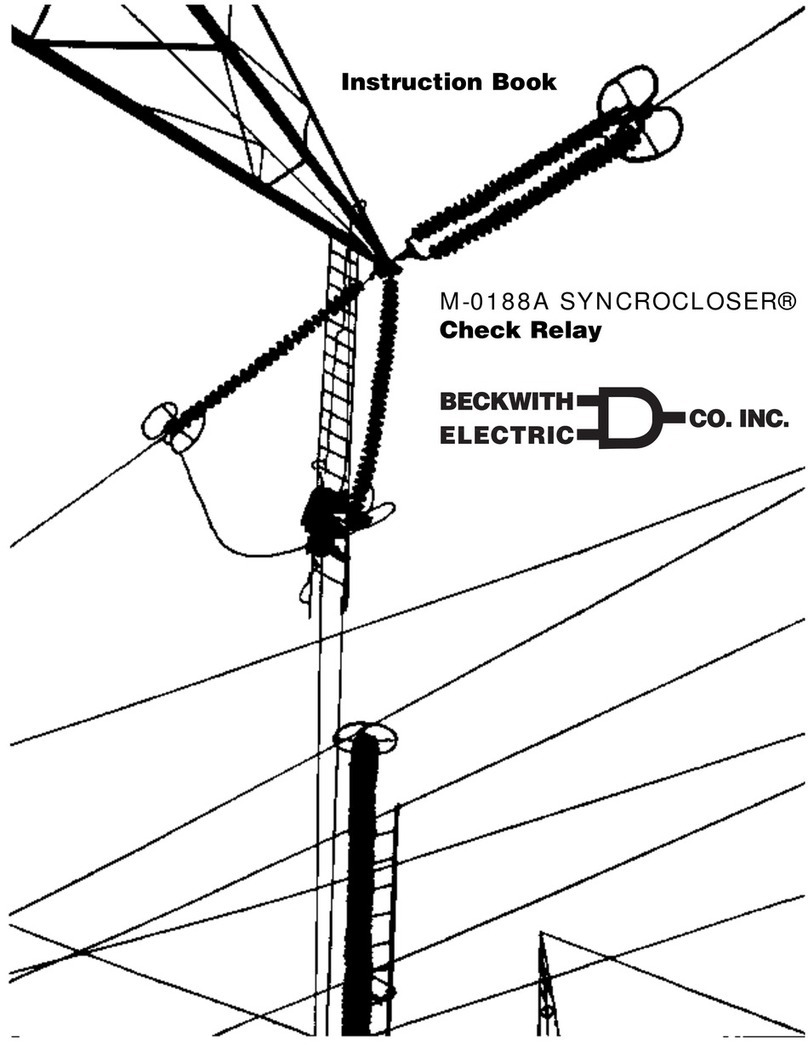
BECKWITH ELECTRIC
BECKWITH ELECTRIC SYNCROCLOSER M-0188A User manual
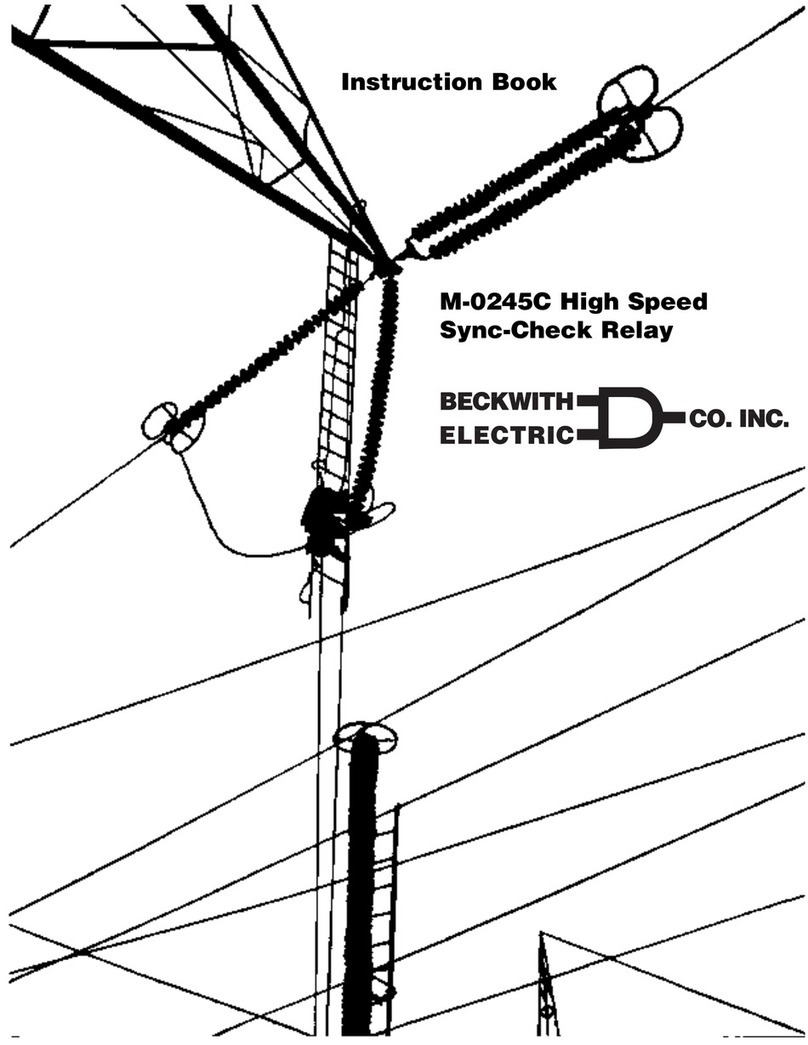
BECKWITH ELECTRIC
BECKWITH ELECTRIC M-0245C User manual

BECKWITH ELECTRIC
BECKWITH ELECTRIC M-3520 User manual

BECKWITH ELECTRIC
BECKWITH ELECTRIC Syncrocloser M-3410A User manual
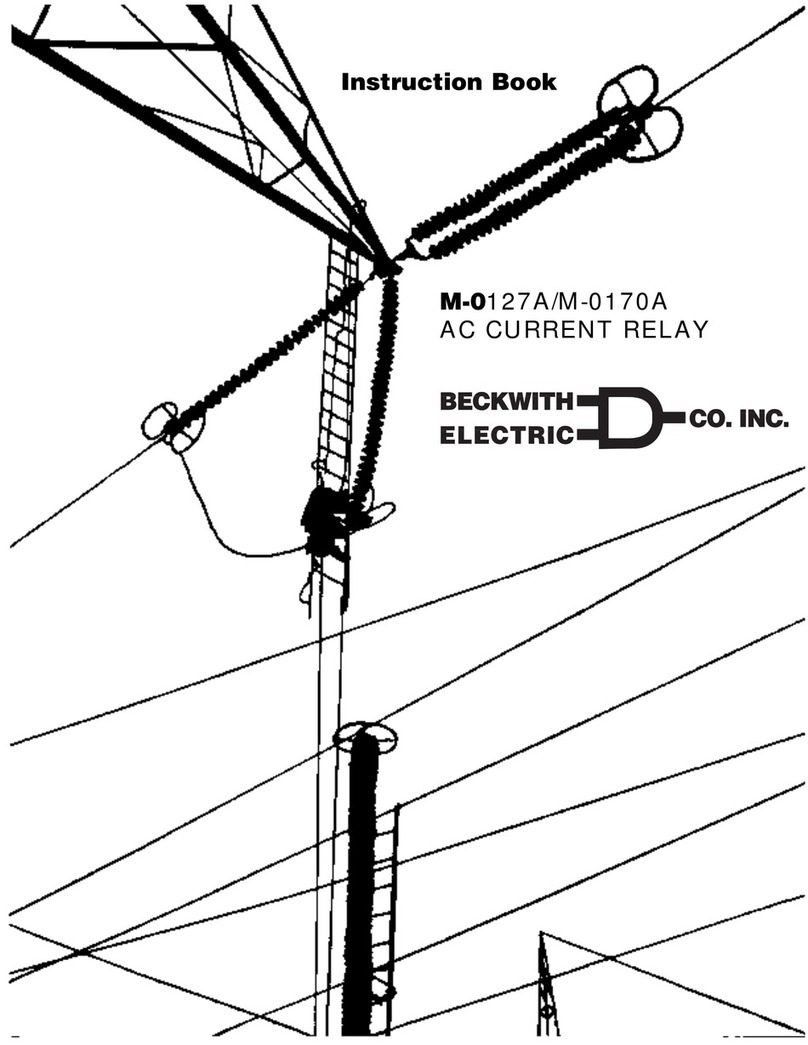
BECKWITH ELECTRIC
BECKWITH ELECTRIC M-0127A User manual
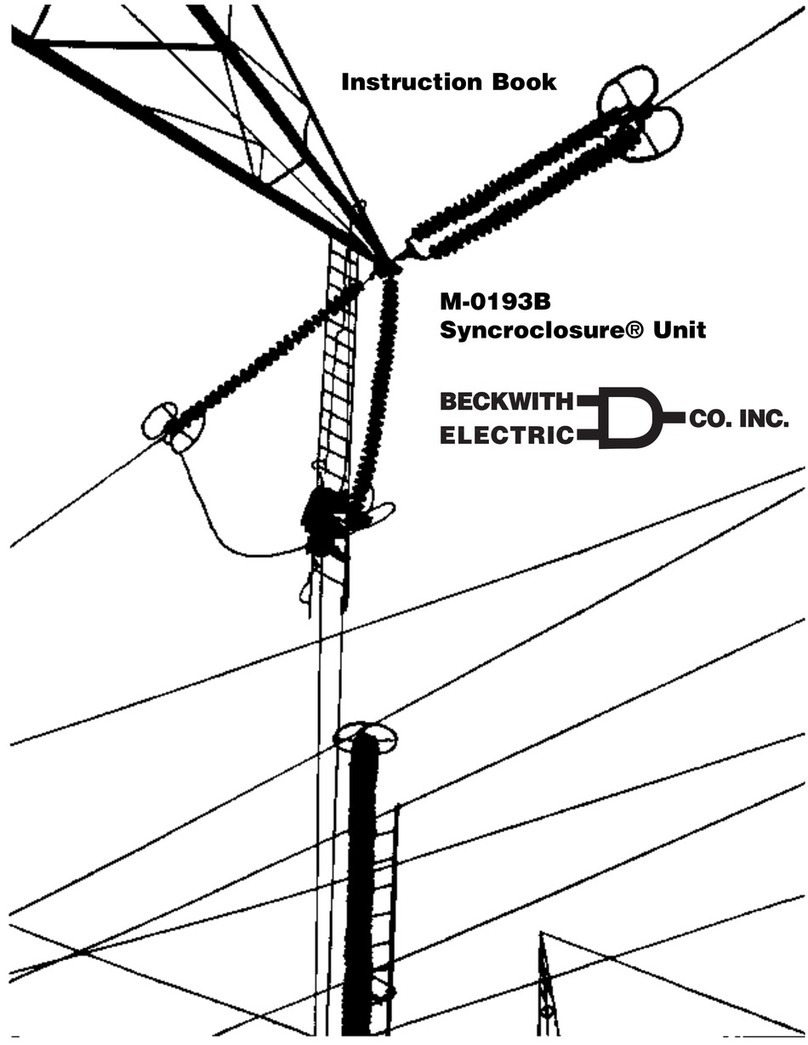
BECKWITH ELECTRIC
BECKWITH ELECTRIC Syncroclosure M-0193B User manual

BECKWITH ELECTRIC
BECKWITH ELECTRIC M?3311A User manual

BECKWITH ELECTRIC
BECKWITH ELECTRIC M-0236B User manual

BECKWITH ELECTRIC
BECKWITH ELECTRIC M-3425A User manual
